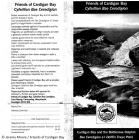Content can be downloaded for non-commercial purposes, such as for personal use or in educational resources.
For commercial purposes please contact the copyright holder directly.
Read more about the The Creative Archive Licence.
Description
Mike Alexander is a trustee of the Wildlife Trust of South and West Wales, and has previously worked as a warden on Skomer Island. In 1988, Mike was working as the reserve warden in North Wales, in Meirionnydd. One of his sites was Morfa Harlech, a wonderful sand dune system. Mike recalls a rather unusual phone call, taken on a Friday, regarding a "monster on the beach".
For accompanying photographs, please see: https://www.peoplescollection.wales/items/1561961
Transcript as follows:
"My name is Michael Alexander and at the moment I am retired. I am a trustee of the Wildlife Trust of South and West Wales, amongst other things. I am talking of a time way back in September 1988 when I was the reserve warden in North Wales in Meirionydd and one of my sites was Morfa Harlech, a wonderful sand dune system. It was quite late in the afternoon when I had a phone call from a person who did not give his name but I recognised him as a local farmer. He said “There’s a monster on the beach – you’ve got to do something about it! It’s bigger than a cow and it’s a bit like a Volkswagen car.” And that was it – he put the phone down.
Well I thought I‘d better go and investigate – so up to Harlech, and sure enough on the beach there was this monster, as he’d described it. In fact, it was a turtle. At that stage I vaguely recognised it as a leatherback, but no more than that. It was freshly dead – it was a remarkable specimen, bigger than anything I ever imagined possible. So what do you do with something like that? My obvious thought was that this needs to be in a museum somewhere. I phoned the Cardiff Museum – National Museum of Wales – and at first they were very reluctant, they weren’t terribly interested. They said, “Why don’t you bury it in the sand? We’ll dig it up later and have the skull”. I thought this isn’t quite right – I knew Peter Morgan, the head of Zoology, and eventually got to speak to him, and he was so enthusiastic but his problem was that this was a Friday and he had no transport available, and we knew we had to get it down into a deep freeze as quickly as possible.
It wasn’t an issue for me as we had land rovers and trailers and all sorts, so I was able to borrow a very, very large trailer and with help from all sorts of people we managed to get the turtle onto the trailer. So very early – at 4am in fact on the Saturday – we drove down to Cardiff with this open trailer with a huge turtle in the back. I’ll never forget arriving at the steps in front of the museum in Cardiff and Peter coming out – the shock on his face was absolutely amazing. He realised straightaway that he couldn’t handle it there – it was far too big, but the museum fortunately had a cold store near the docks in Cardiff. So off we went to the cold store and he hired a crane. And it was as the crane lifted the turtle that we began to realise quite how big it was – because the alarm bells went off: we were exceeding the legal weight that the crane could lift. We realised that at that time in fact that we probably had the biggest turtle that had ever been recorded.
The rest in a sense is history – the stature and important find, that people were involved and interested all over the world. A team came over from the States to help with an autopsy, and eventually the turtle ended up in this quite spectacular display in Cardiff, it was there for many years. It is still in Cardiff and on display, though not quite as spectacular as the original.
There’s a rather nice tail end to the story – a year or so later I was doing some work in Costa Rica for the Costa Rica Wildlife Service, the National Park Service, and we were on the Pacific beach at 3am with permission to go and see the leatherbacks coming ashore, and this rather irate person came up – he was a research worker and he wanted to know what we were doing there disturbing the turtles. I completely was looking at the turtles and my friend spoke to him, and he asked us eventually when he calmed down where we were from – and he said we were from Wales. He said: “Oh I know all about Wales – I hear the biggest turtle in the world was recorded there.” So, of course, my friend took delight in telling him that I was the person that found it.
But it was wonderful seeing these huge turtles alive. I suppose the enduring memory of the turtle I found was one of sadness, deep sadness particularly because of the way it died. When they conducted the autopsy, they discovered its gut was full of plastic bags it had eaten, believing of course that they were jellyfish – desperately sad.
That’s my story – thanks for listening."





Do you have information to add to this item? Please leave a comment
Comments (0)
You must be logged in to leave a comment